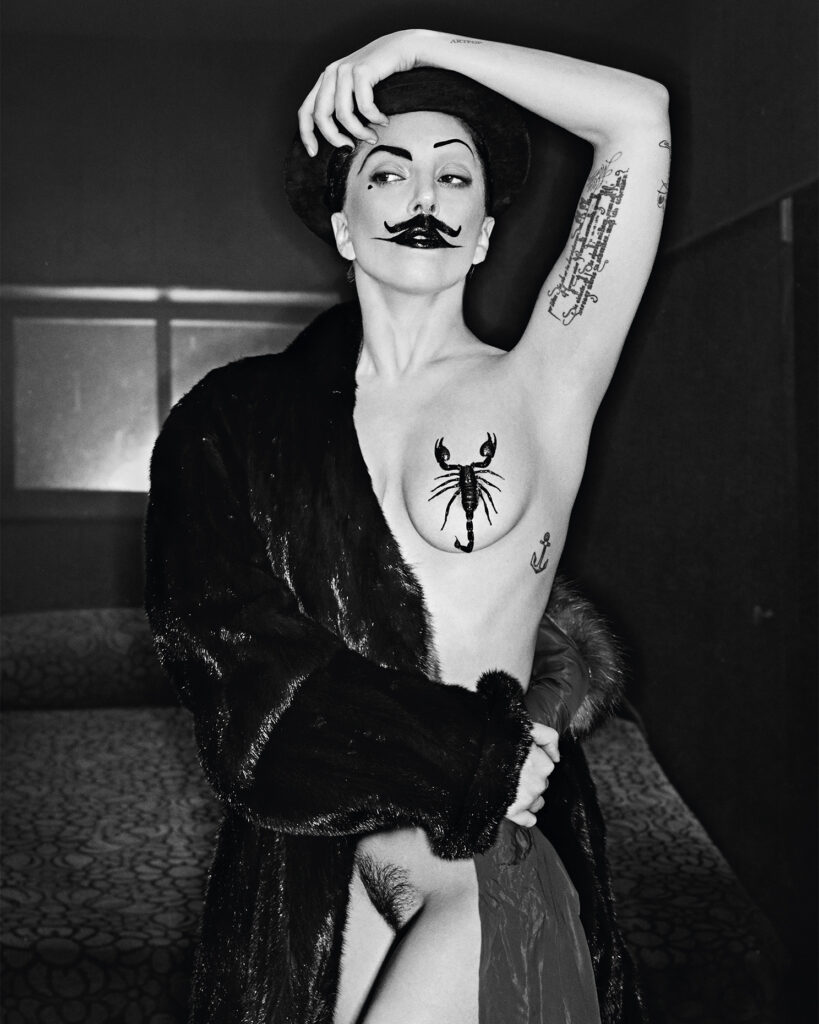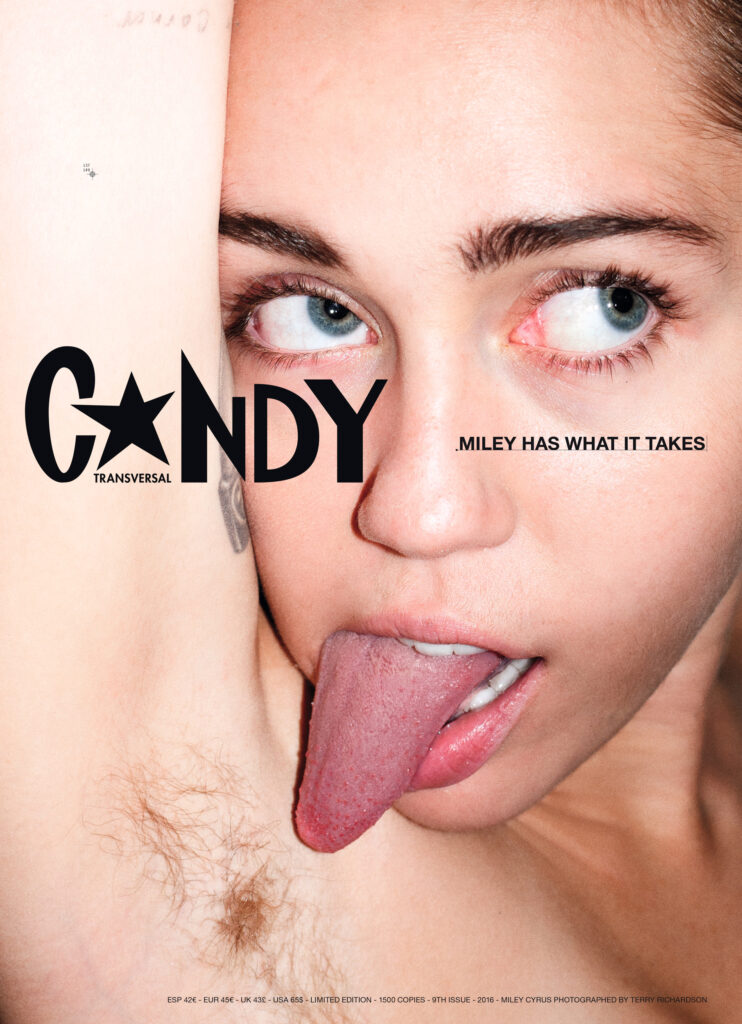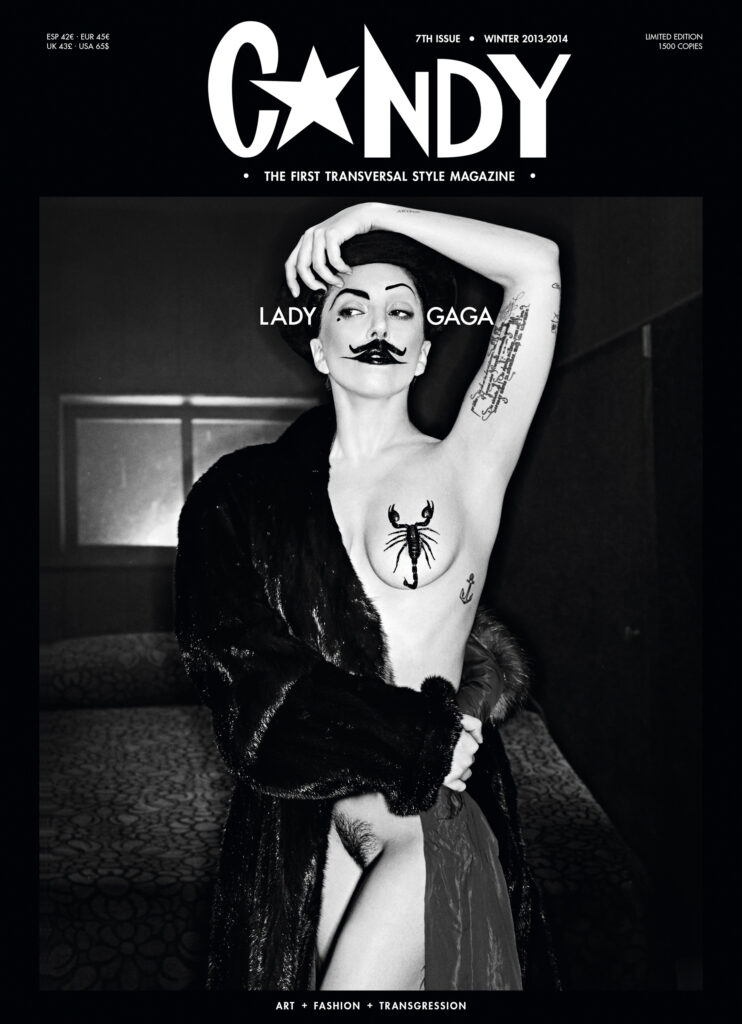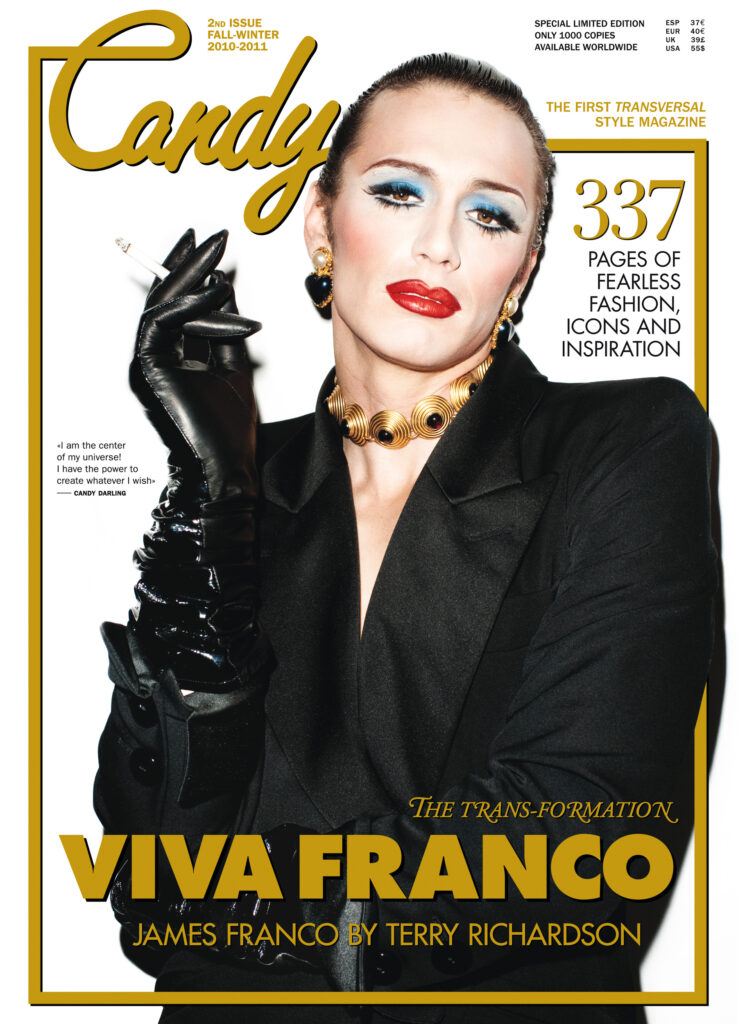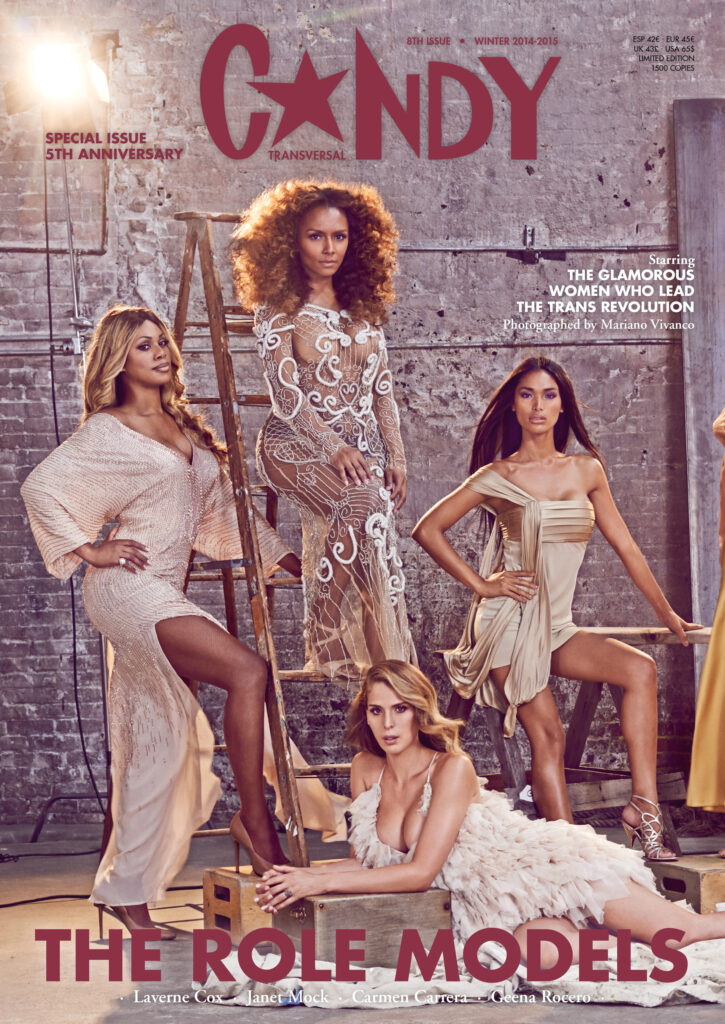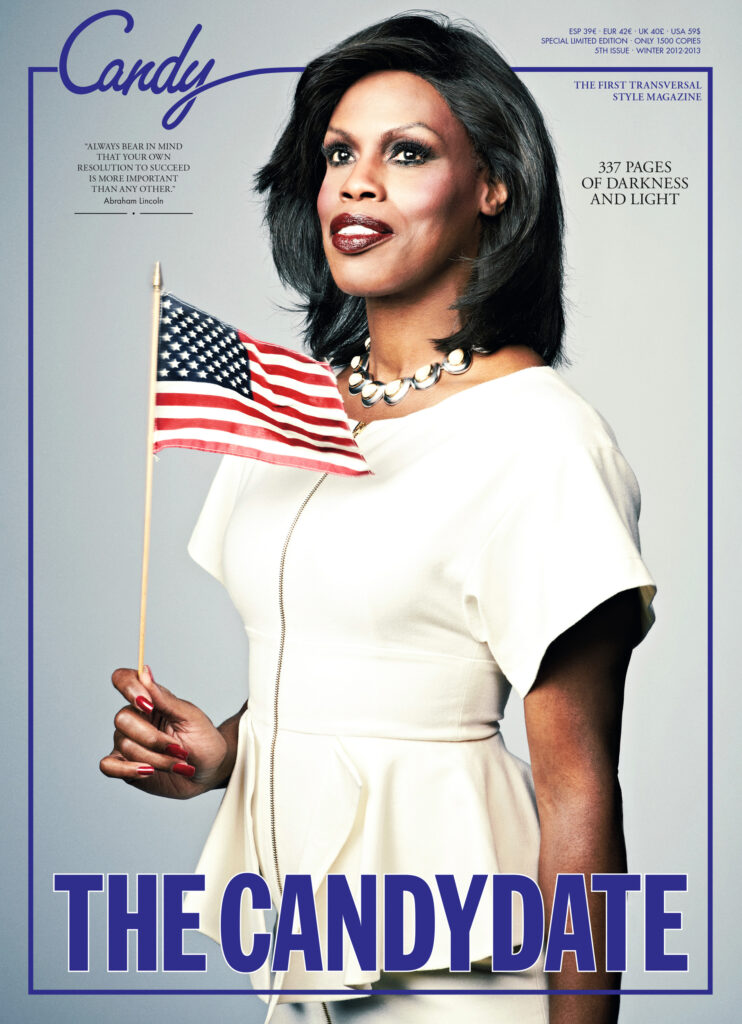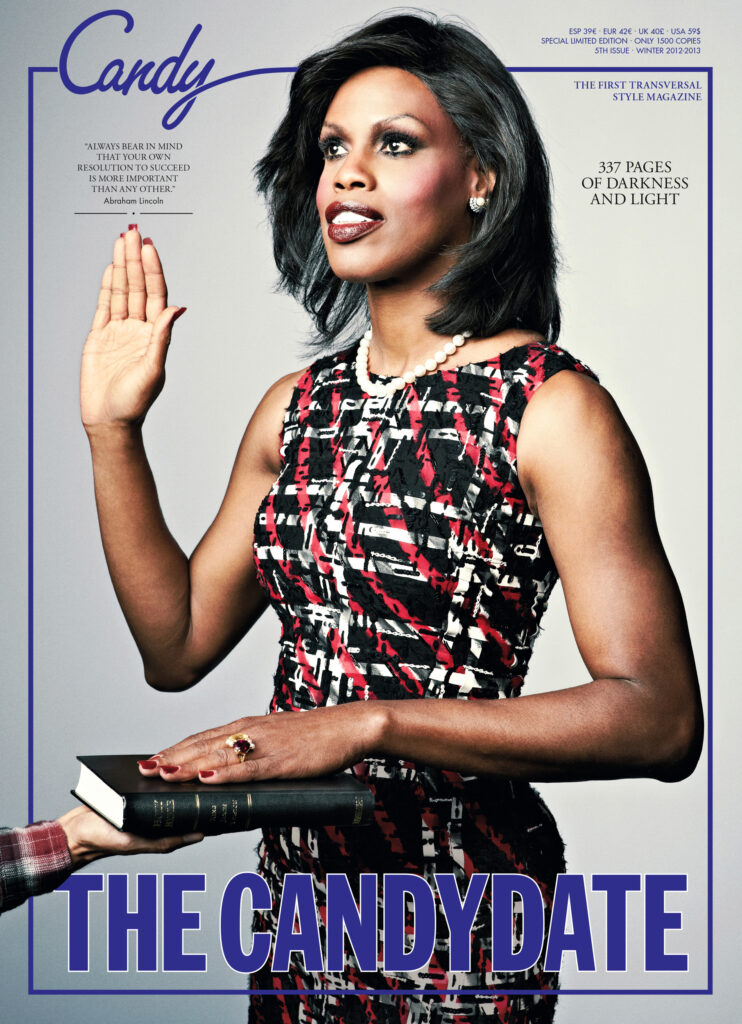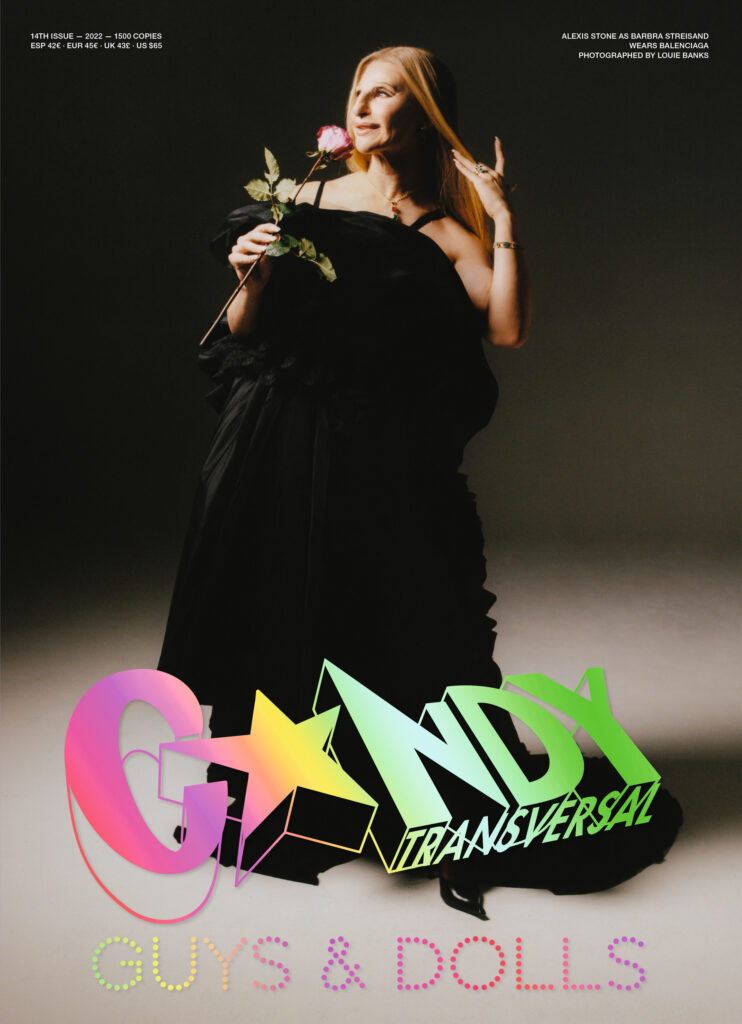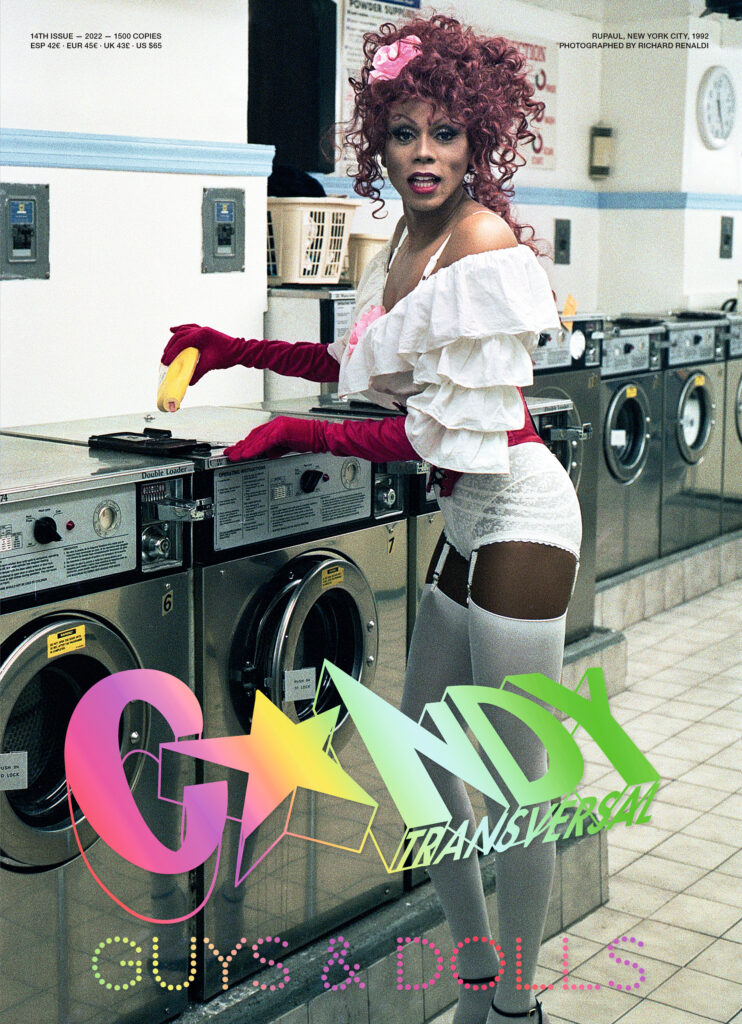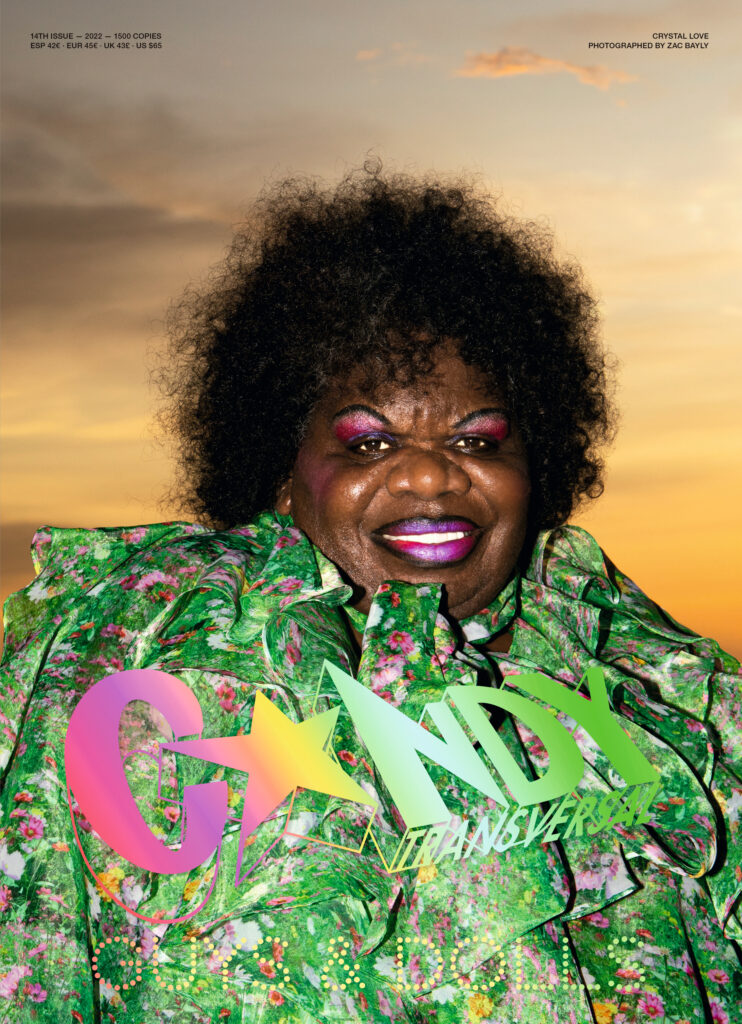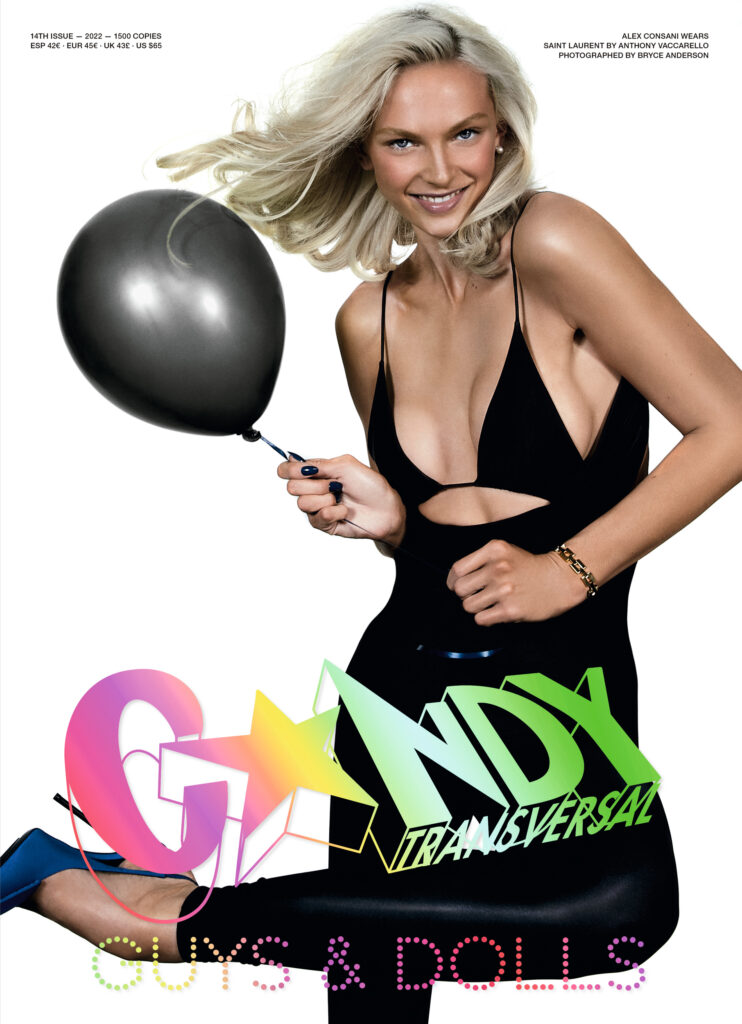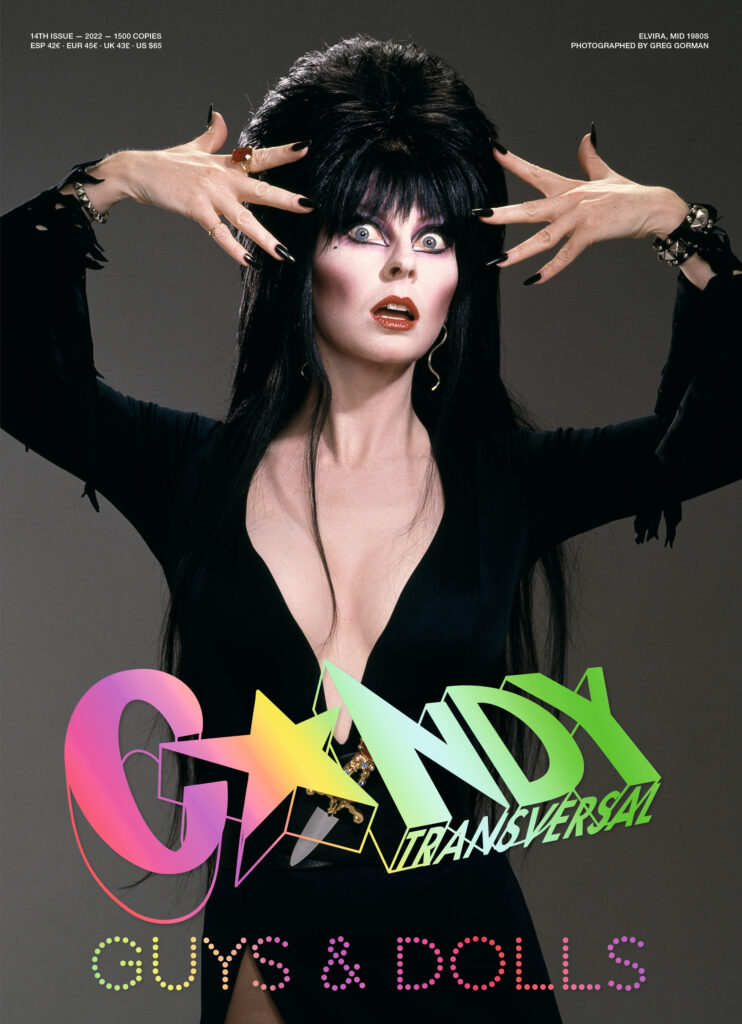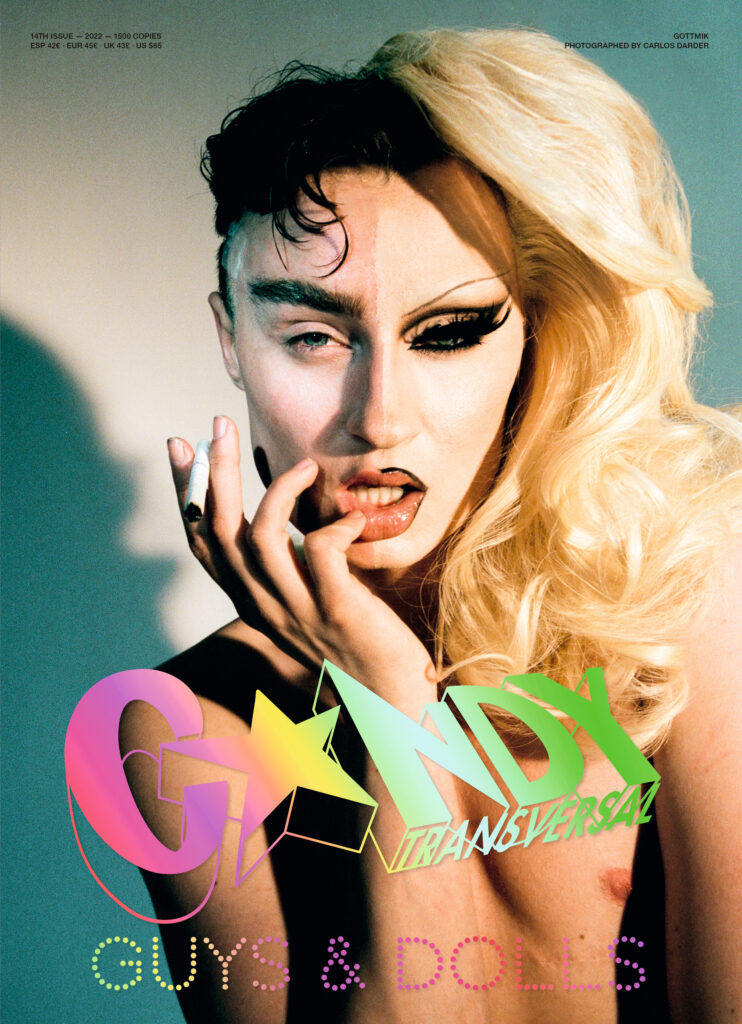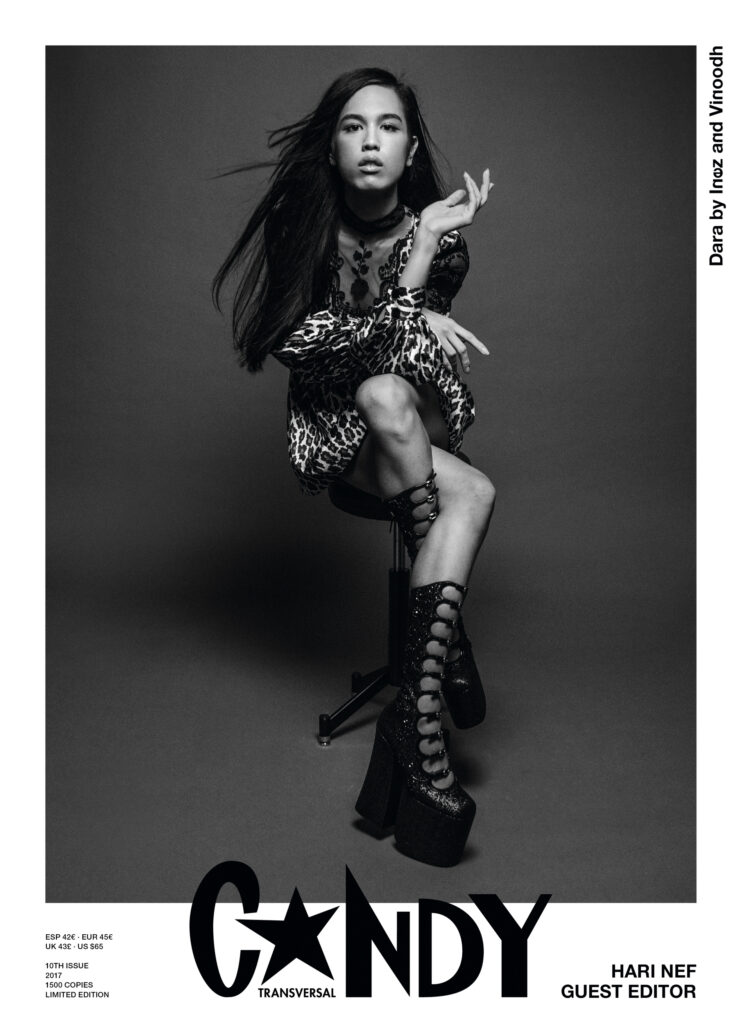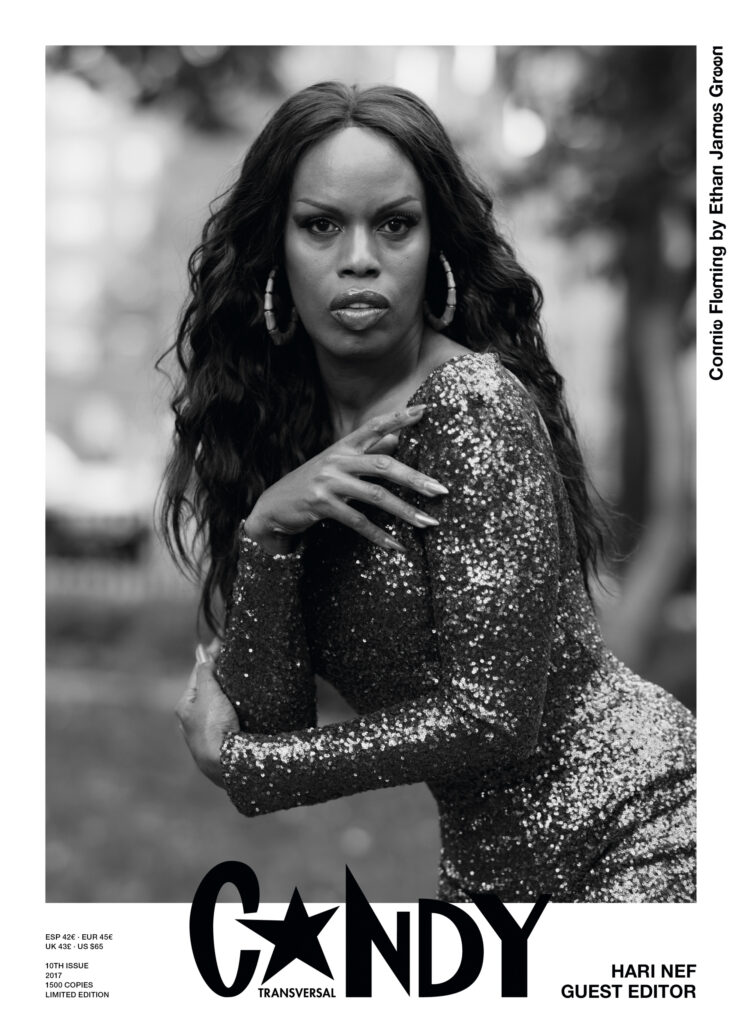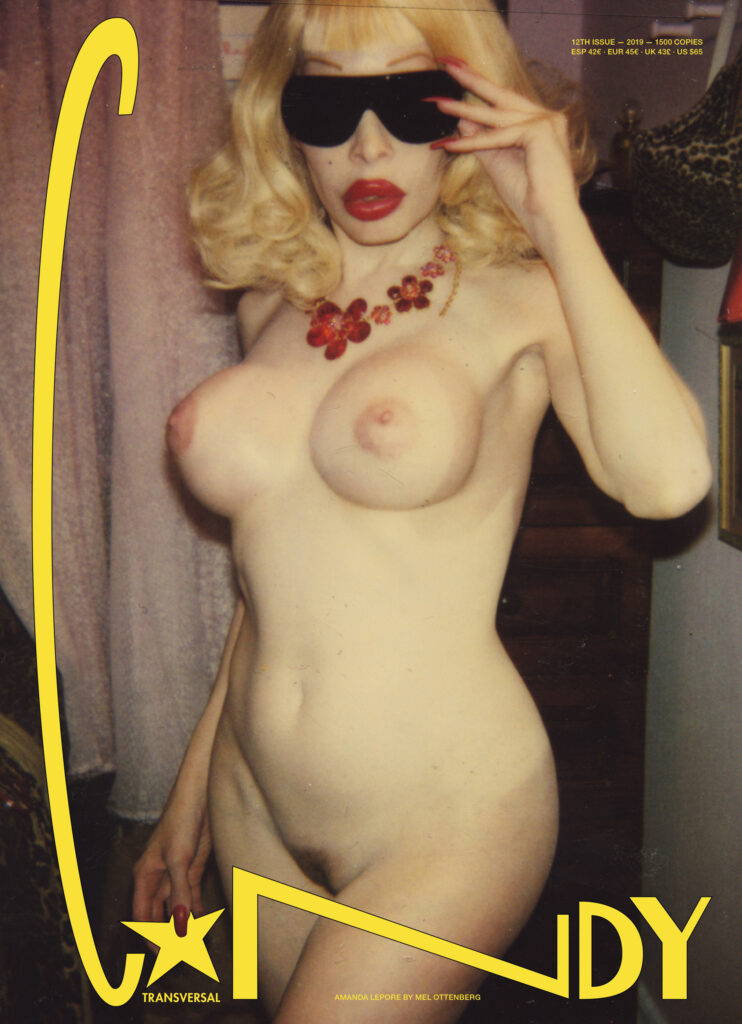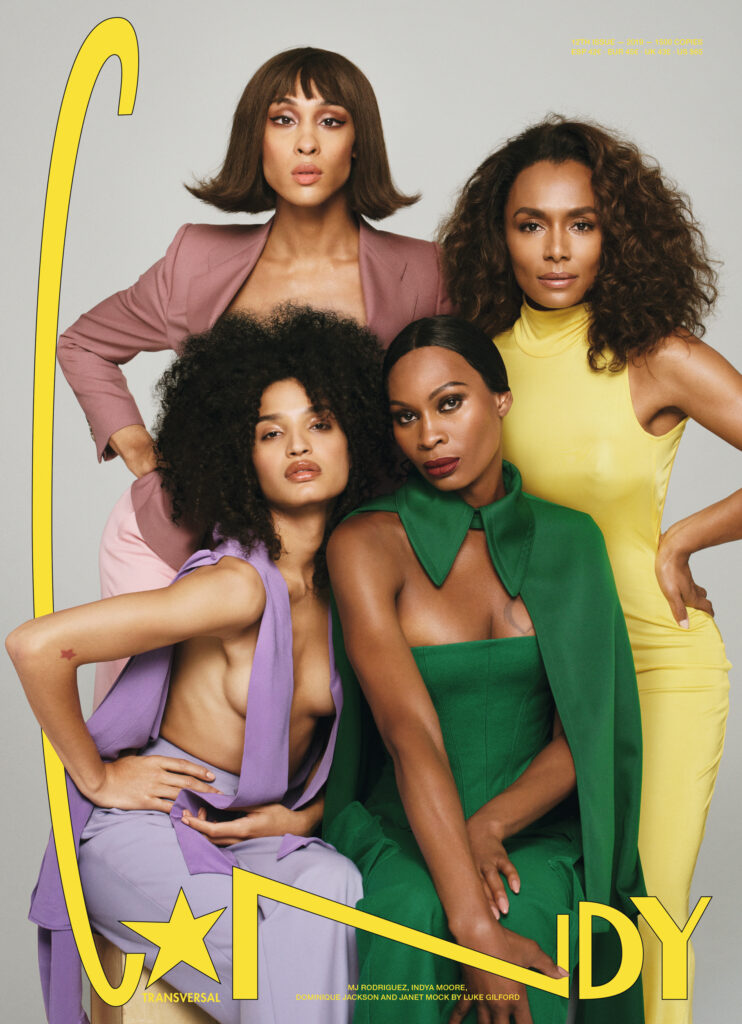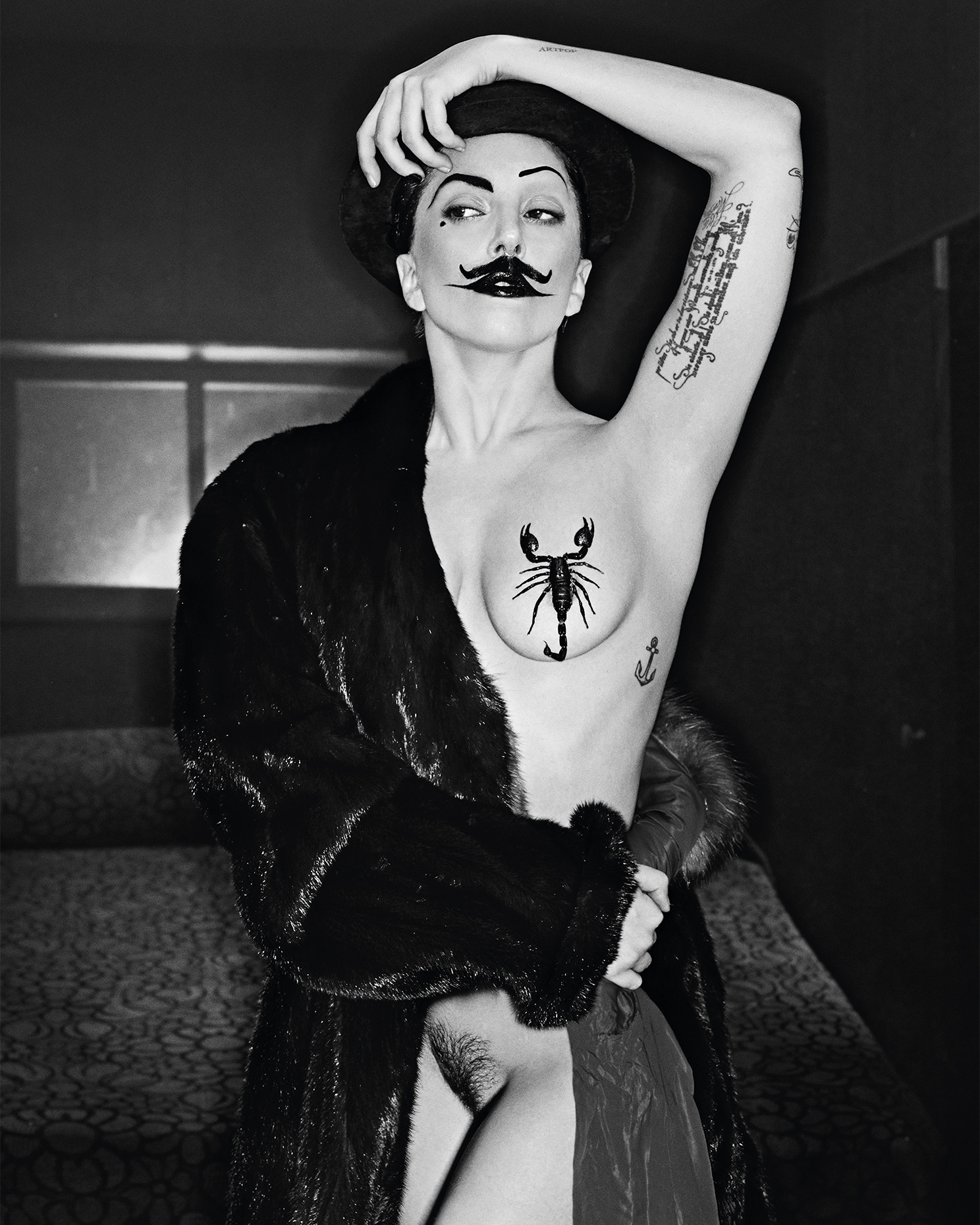Founded in 2009, C☆ndy Transversal was arguably the first of its kind: a trans fashion magazine. Nearly 15 years later, editor-in-chief Luis Venegas continues to honor the fabulous faces that built fashion history.

KEVIN PONCE: I was showing Savannah some pages of C☆ndy and I was like “Let me show you where the dolls get to play!” She said, “I’m loving everything you’re showing me.”
LUIS VENEGAS: Thank you! I really appreciate it.
SAVANNAH SOBREVILLA: This is a story about queer magazines, but I’d love to know how you got started in publishing.
LUIS VENEGAS: The thing is, talking about queer zines, I think everything I’ve done, all of my publications, were queer zines because I’m a queer person. I never thought of myself or my publications to be under the umbrella of “queer.” I wanted to celebrate things that I felt needed to be celebrated and maybe weren’t. And somehow someone put the tag of “queer” on my publishing work. I felt like that t-shirt that says, “Sounds gay. I’m in.” I loved it. Within the world of the arts— maybe this year something will change—this idea of “queer” art felt less important. To me, it’s a superior art.
Anyway, I was making my magazines, but I was making magazines related to different subjects like art and sexy men. Then I was wanting to do something with fashion because that’s what I had always wanted to do. But what could be relevant in fashion back in 2009? I remembered everything related to transgender people and drag queens and, back then, androgyny. They had been around fashion forever. Fashion was allegedly a very inclusive profession, but for some reason, there was never a magazine [focused] on celebrating all those people. To me, it was about time.
KP: What made it that time for you?
LV: There’s a lot of culture that no one is paying attention to and connecting the dots in terms of fashion. There has always been so much inspiration that the trans-versal world—trans and universal—has given to the world of fashion, and fashion hasn’t paid anything in return.
SS: How did you go about doing that?


LV: First, I wanted to celebrate them. Candy Darling was a fabulous fashion icon. Maybe some people had forgotten about Candy Darling, but she was amazing. Marsha P. Johnson was, of course, a pioneer and an activist, but she was also a fabulous woman with great style and great energy, and I wanted all of that to be celebrated in C☆ndy. To me, it wasn’t a political statement. It was more about celebrating the fashion and the creativity, but by doing that—because, honestly, no other magazine was doing it at the time—it was a political thing. It’s funny because at that time putting a transgender person on the cover of a magazine was something like, “Wow, really?” I mean, I remember when I started C☆ndy, I needed to deal with brands for advertising.
KP: Oh my god. How was that?
LV: Most brands were reluctant. They were like, “Oh, but it’s gonna be a tacky magazine, no?” I was like, “No, it’s the opposite of tacky!” But it felt like that at that time. “It’s going to be kind of dark, no? Related to sex work, right?” But when they saw the first issue—I don’t know, I’m saying this about something that I’ve done myself, but is not new—it started a trend and the trend is here to stay.
SS: How so?
LV: I mean, now, it’s certainly not news to have transgender models on our runways at all. But back then it wasn’t happening. In 2009, it wasn’t happening. There were no trans models in advertising campaigns. I mean, it was really a whole world of people that was kind of non-existent to the rest of the world—the fashion world, at least. I remember when I [started] C☆ndy and, like six months later, there was this fabulous Brazilian model, Lea T, in a Givenchy campaign and there was Andreja Pejić also doing campaigns for H&M or for other things.
I always say to people, you know when you go to a lake that is really calm and you pick up a little stone? You throw the stone and somehow that thing that was calm and quiet starts to make waves, little waves. And those waves become something else and they spread. Some people notice that little movement and take note. Somehow, I feel like C☆ndy did that. There were zines, underground zines, and maybe there was an article about a transgender person here and there, but never a whole fashion magazine focusing on all those matters specifically. There was an excitement about C☆ndy in the early years of making it because there was nothing like that.

KP: Who were some of your contributors?
LV: I was actually just telling this to a friend who’s a contributor to the magazine, a fabulous trans woman who’s been contributing for a while. I told her “Maybe it’s about time to stop doing what we do because it’s not new or exciting.” And she told me, “No, because not only are you featuring the most exciting new trans people and drag queens of the world, you’re also showing us the elders of the community, or people who maybe have no Instagram at all.” I love to put new people in every issue of C☆ndy. I don’t care if they’re not famous. As long as they are relevant to me or they have a story to tell or I find them beautiful. And by beautiful, I mean they have beautiful stories or beautiful memories to share. I love to do that and to put portfolios of rare photographers. So she told me, “It’s not only about what is happening now, it’s also giving us a cultural background, which is often quite rare for queer people in history.” There’s much more of a conscious purpose now to document, archive, and celebrate all many kinds of identities. But again, it wasn’t something so obvious some 15 years ago. I’m happy I was able to give some little bricks to keep building the house, the institution.
KP: I would say yes, you did help build that house that matters to girls like me because I remember C☆ndy from my own personal experiences when I was younger. I first saw the James Franco cover shot by Terry Richardson and I was like, “Well wait, what is that?” And that was before I came to terms with myself as a trans woman. I was like, “Oh my God, a magazine that is exploring the realms of gender from one end to the other.”

LV: Many people have spoken to me about the James Franco cover. These days, it would be kind of controversial.
KP: Oh, yeah.
LV: Because [people could think] “What is this straight man doing, queerbaiting in drag?” At that time, that was something that was perceived as a positive thing, I’m very aware of that. But I also know that, with time, perception changes. When I ask myself if I would do that again, I would say probably not because I know how culture changes. That’s part of the great thing of being alive, you know? Making magazines, in particular, it is a constant learning process.
KP: And to that point, I’ve seen the evolution of C☆ndy go from James [Franco] to Alex Consani on the cover looking fabulous—and in great fashion, too. It’s funny that we brought up James because I think the evolution is what interests me most. In more recent times, for example, we’ve seen Eddie Redmayne take on a transwoman role for a film and get such backlash for it. I think he, his team, and the team that was producing that movie, were maybe stuck on one end of where culture is now where they thought it would be acceptable. I’m curious to know how that shift has affected readership. Seeing the reader from 2008/2009 compared to the reader of 2024, do you think the audience has evolved as well?
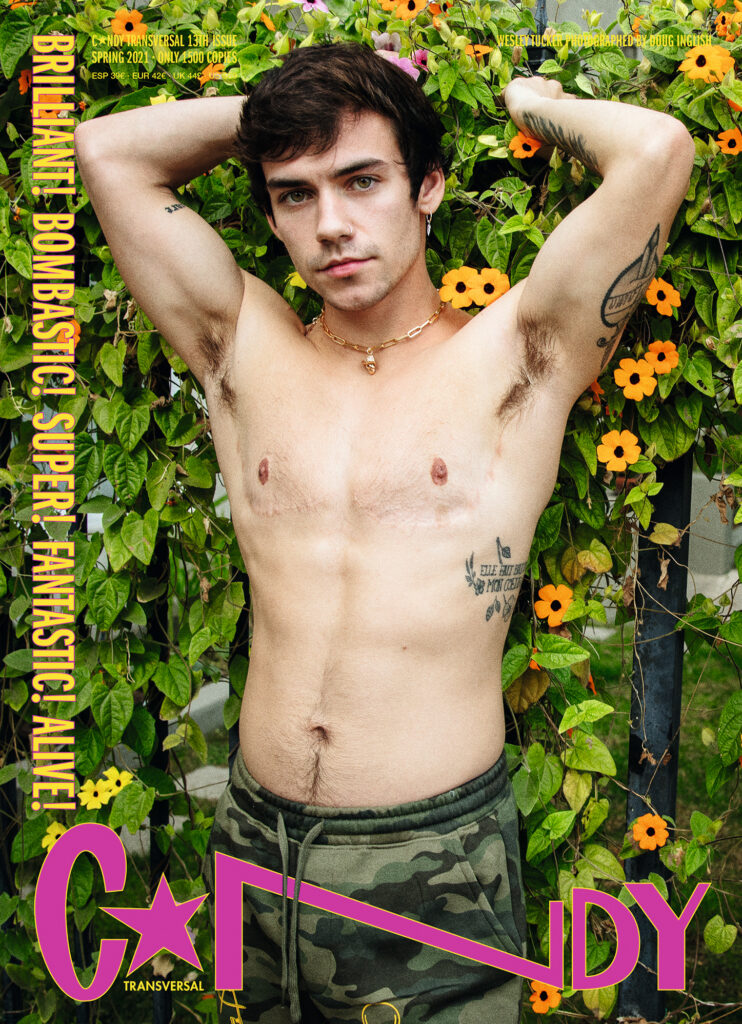
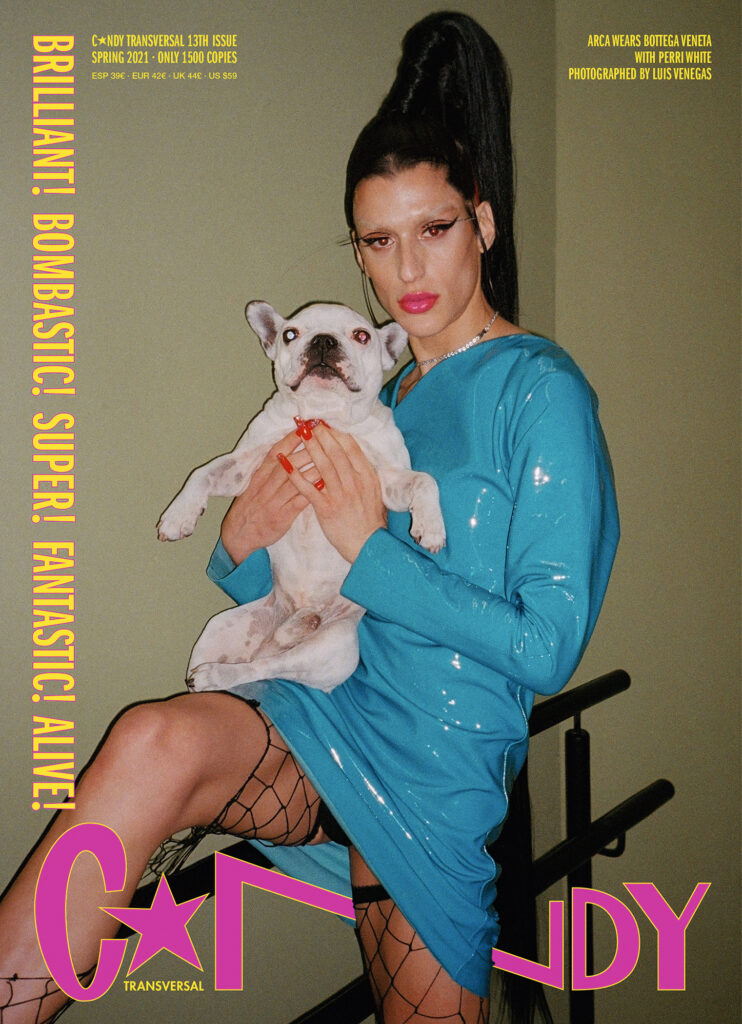
LV: Oh yes, I feel like as much as I like that we have much more knowledge, at the same time, I worry a bit about that sometimes we can get too concerned about doing something that is too right and politically correct. Of course, [those efforts] I like, and I don’t want anyone to be upset with anything that I produce. It’s also something that can be beyond our hands. I’m sure Eddie Redmayne when he was doing The Danish Girl, felt like he was doing something positive, I don’t think he was pretending to cause any pain. He just had good intentions, even though it was done in the wrong way, so it’s good to learn. It’s good to acknowledge where the intentions come from. I [sometimes] think, if I had a chance to do another James Franco-type cover again now, 15 years later, I would love to see the evolution because what does it say about society and culture these days?
SS: Yeah, create something that invites questions and conversation and discourse.
LV: I feel like when I was first starting C☆ndy, the fact that I was a bit more clueless, made me more fearless. For example, for the eighth issue of C☆ndy, I did a fold-out cover that was for the fifth anniversary of the magazine. And I called it “The Role Models,” like Vanity Fair style. And there was Laverne Cox, Carmen Carrera, Geena Rocero, Janet Mock, I mean, Janet told me “This is really great. We’ve never seen this many Trans women of color on a magazine cover ever before. And [when doing that cover], I wasn’t specifically thinking of them as trans women of color. Still, I realized later, [I was thinking about it as] more about their personalities, and their fabulousness as it wasn’t intentional to celebrate a specific thing. Still, at the same time, I think it came from a much more honest way because to me, I was just seeing them beyond that.
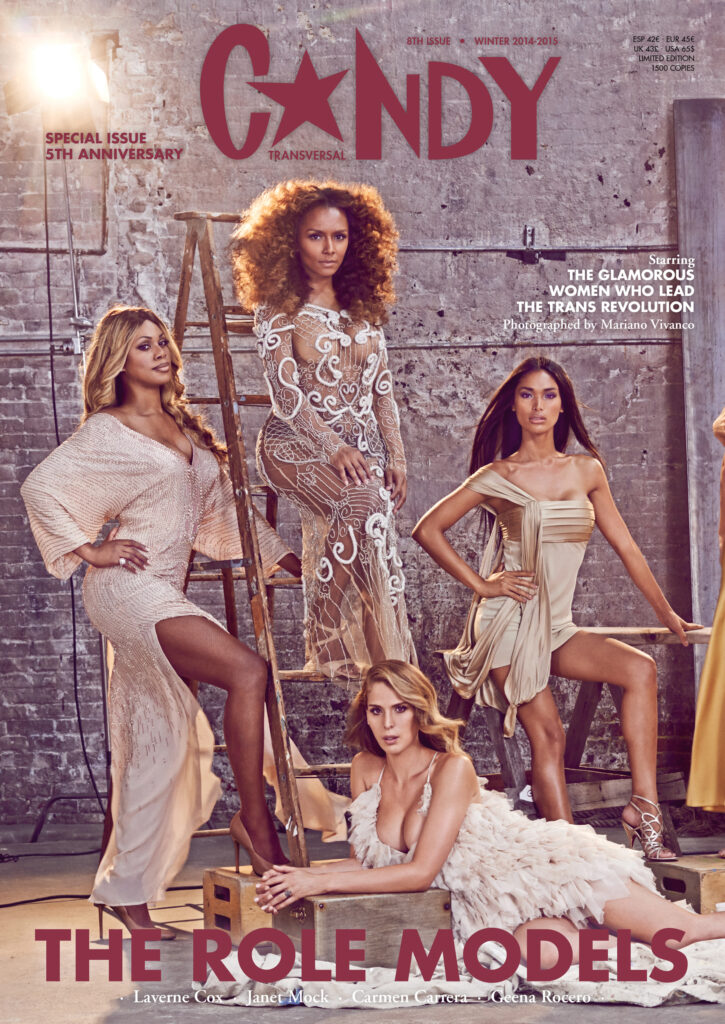
SS: It’s so interesting too because when you really see someone’s talent, and like you said fabulosity, you just recognize it and you’re not looking out like “Okay, I need more Black people in this shoot, I need more Asian girls, you’re just like, well, they’re all the most fabulous ones that I know.”
LV: There’s a good intention. You’re totally brave because, at the same time, it sometimes could feel a bit like tokenism. [No matter what], it’s going to help somehow push things forward in the long term because it matters to people, and to trans women of color seeing that kind of representation. I’m happy that somehow this happy accident happened. It made me think about how I somehow started in an innocent way where I wasn’t really conscious [about casting], it was a decision that was meaningful to people.
SS: It’s such a great cover. Do you have a copy around?
LV: It’s actually in here, this book we did with Rizzoli called The C☆ndy Book of Transversal Creativity. We also did a fun cover with Connie Flemming like she was a US president. I remember it was [the 2008 Democratic nomination] when the Democratic Party was trying to decide between Barack Obama or Hillary Clinton. And I thought, what if the candidate for president was a fabulous Black trans woman so that’s why I titled the cover “The Candydate” like candidate.
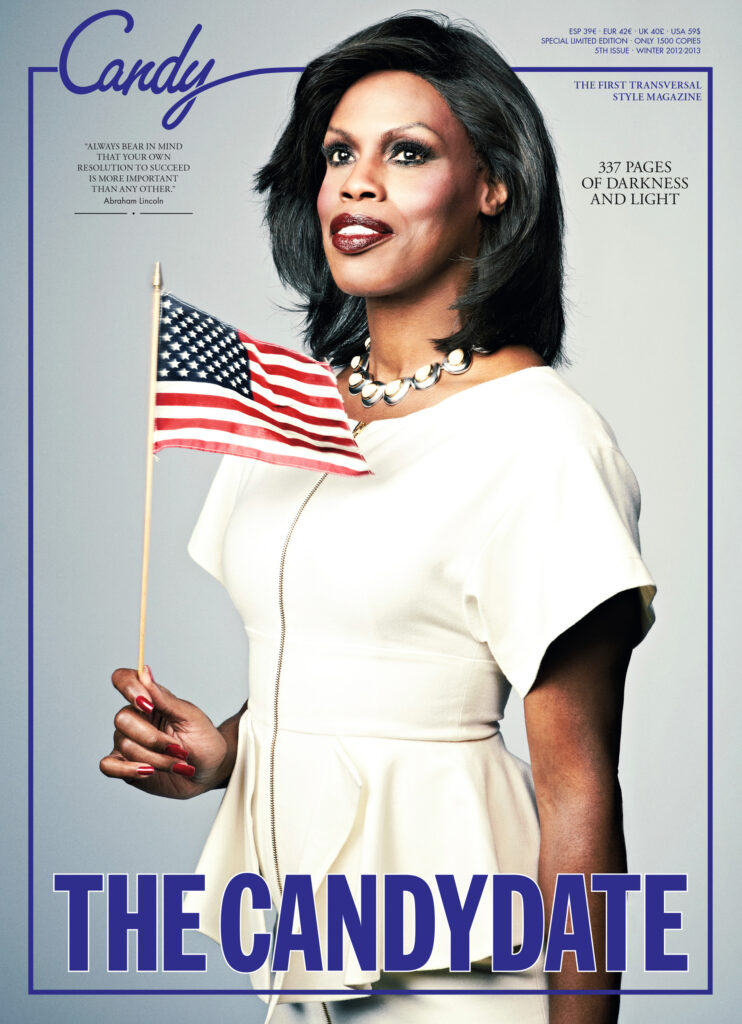
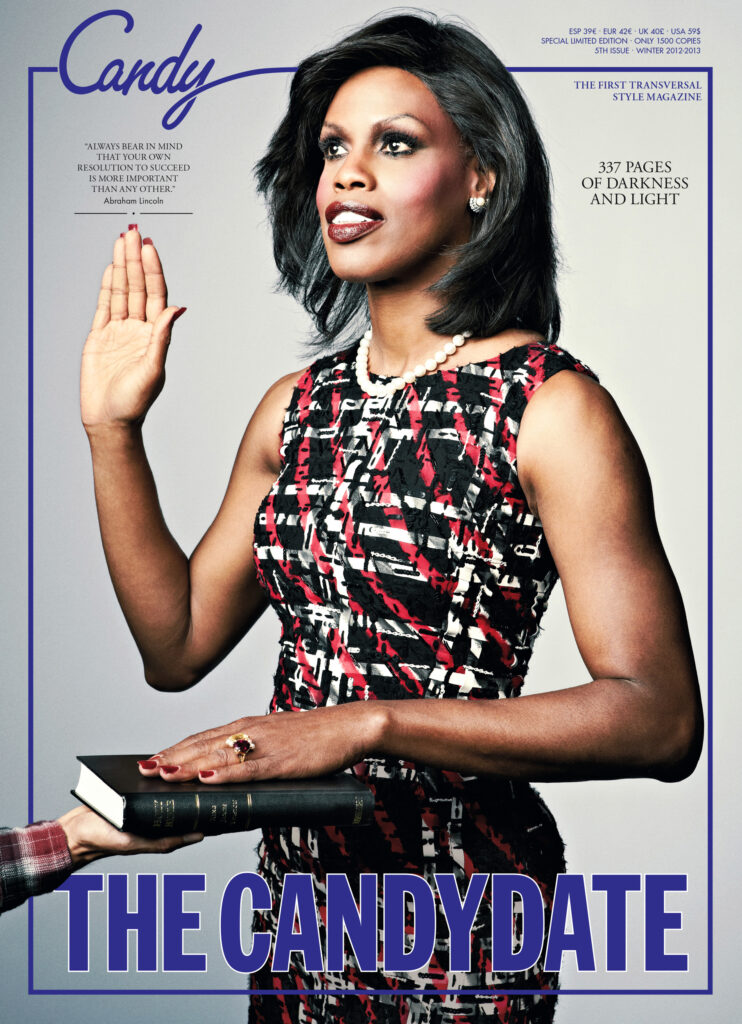
I’ve known Connie for a long time, and I asked her, and she’s so gracious and sweet and everything and looks also a bit like Michelle Obama here. You know, doing a magazine or any kind of publication has to be somehow also be entertaining as much as it has to be meaningful. It has to also feel, in a way, hopeful. It’s an inspiring thing and also entertaining for people to have fun when looking at it.
SS: What are some other cover moments that you’re proud of?
LV: Actually, all of them. No, really, because the fact that I’m still doing C☆ndy, I like the idea of making it look and be perceived as a regular magazine. In a way, I always wanted it to look like a strong fashion magazine. I manage to have C☆ndy work with brands, and of course, it’s complicated to keep it alive somehow but it’s an art project. To keep doing great covers with great people that catch attention, I really fight for every single cover to happen. So when you ask me, “What’s your favorite cover?” I love all of them because I know the story and fight behind all of them. Sometimes, I’ll do many covers because there will be this new photographer that I like and I want this person to have a moment and have their first cover, but something I’ve done since the first issue is to not only have trans people as the subject of the magazine. I want transgender photographers, trans writers, and stylists, I want everything. I want the queer community to become the creators of the magazine because I feel like it’s the honest thing to do. I don’t know everything. I may know some things, but as an editor and as a publisher, I also want to be surprised. Even if I don’t understand a subject well enough, you know, let’s give it a chance because maybe I’m seeing something wrong and this person is right, and I’m sure they’re going to have a connection with someone else. I think also it’s kind of a duty to showcase new talent, and maybe new talent doesn’t necessarily mean young talent, it sometimes calls for 50-year-old women who have written great poetry.
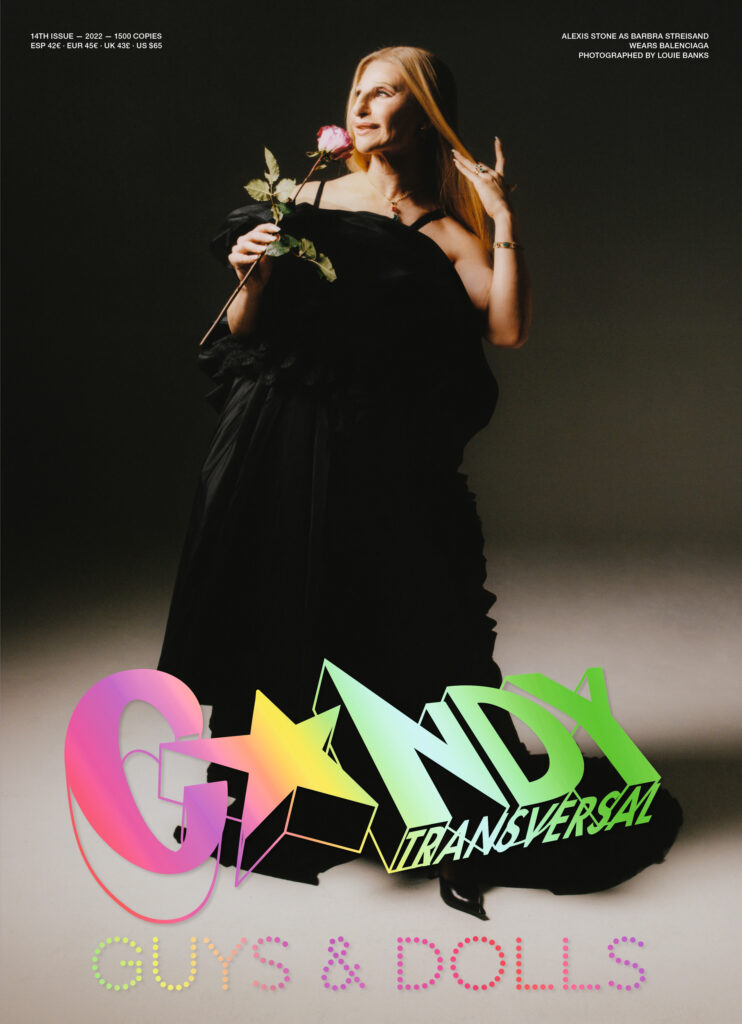

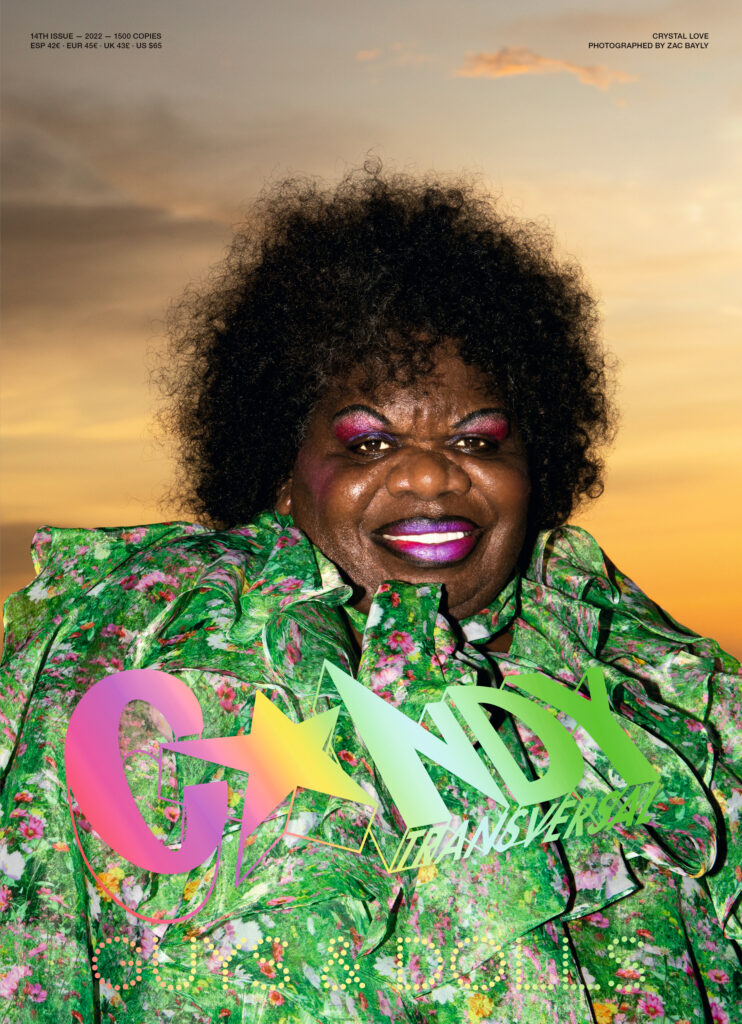
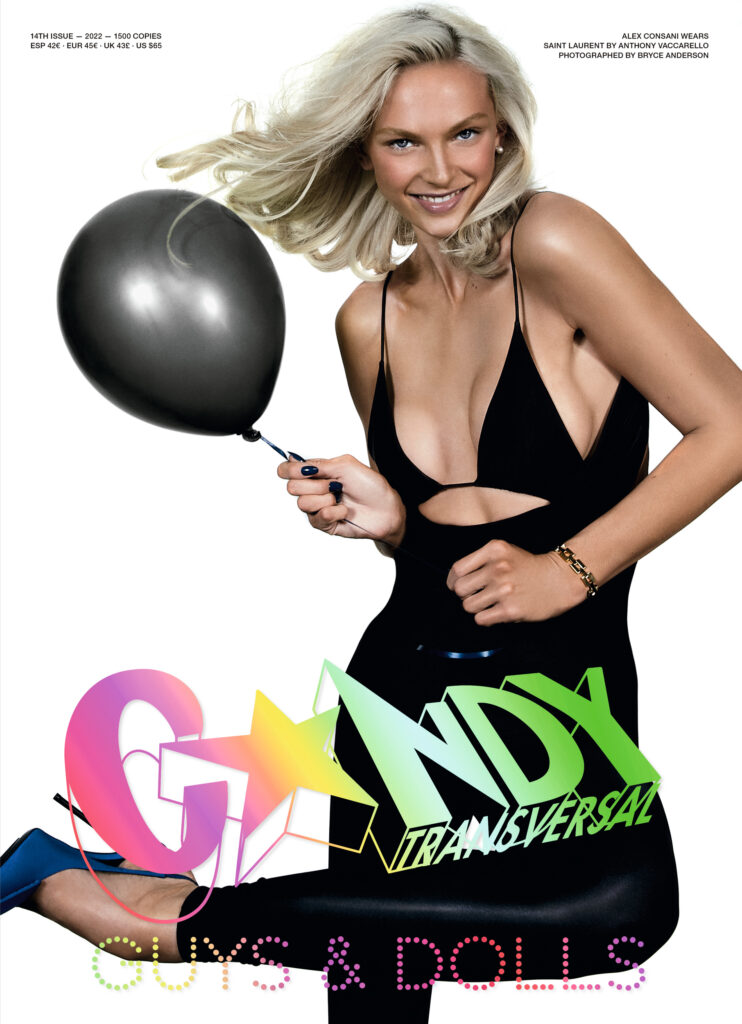
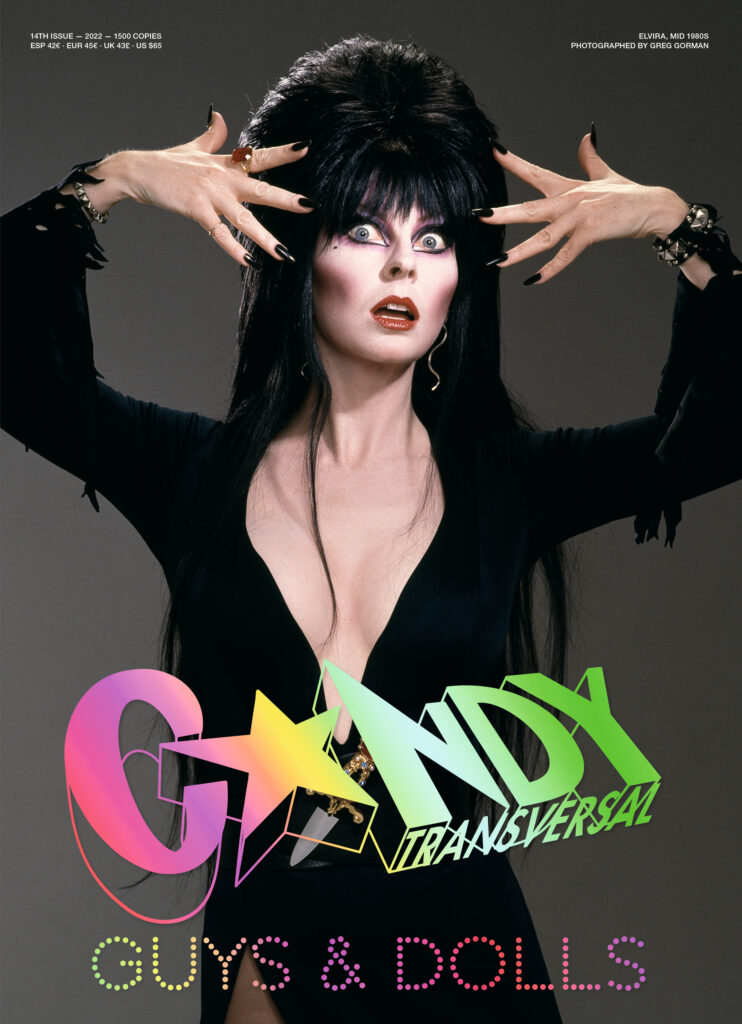

KP: It’s great to hear all that because like you said, it’s not always about new talent. It’s about being current, and age be dammed because it doesn’t really matter. Opening the pages of C☆ndy, you can see anyone from Candy Darling to Bretman Rock and it’s like a party. I always look at C☆ndy like the best party ever where everyone is invited.
LV: I love that description, Kevin. Thanks so much! I love it. It’s really my intention, there’s a lot of mix. I feel it is so much more exciting to find new people and mix the young with the old.
KP: I always say to Savannah “Look for the weirdos in the downtown areas. They are far more interesting.”
LV: I mean, that is so the thing. That’s why I started C☆ndy in the first place, I mean, since I was in elementary school, I guess in a way I was a weirdo too. It also started around the time when RuPaul’s Drag Race was kind of starting up and it changed the perception of the community. Culture changes and you learn and you keep evolving, it’s like a muscle you train. It’s called C☆ndy Transversal and the very meaning of Trans means change, transitioning, and evolution. In different ways, we are living in our own transition, as we are immersed as human beings in this constant process of change and evolution. I want to keep my curiosity in order to keep learning things and to be open-minded, including about myself how I am perceived and how my relationships are with people, with my family, and in terms of identity also.
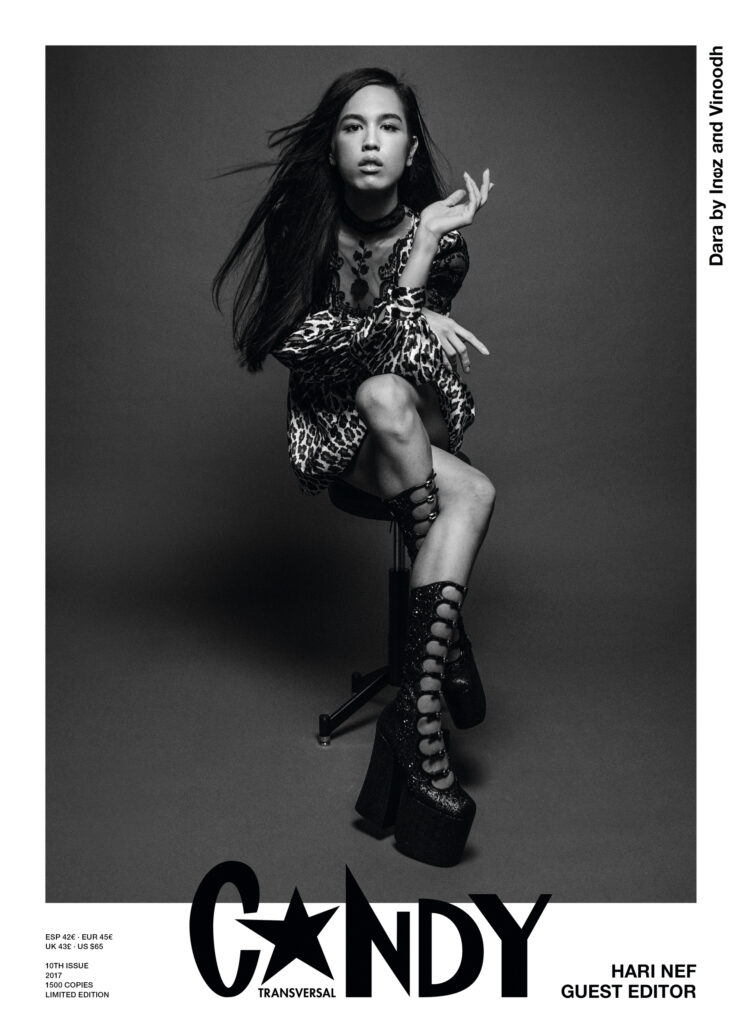
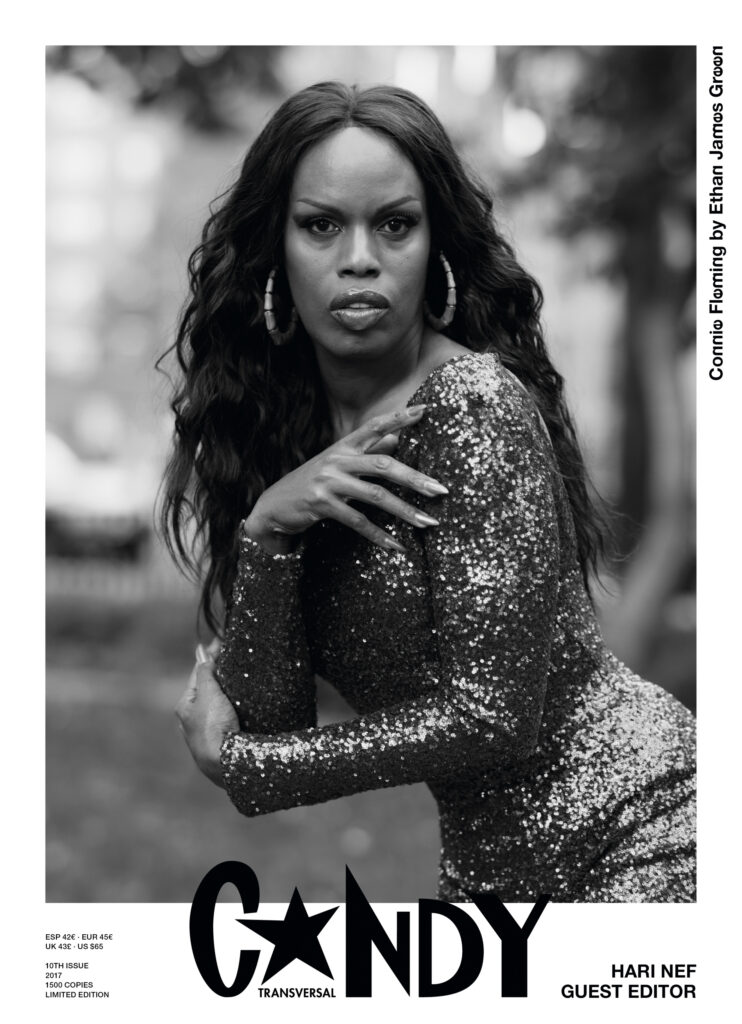
SS: I’m really curious to know what your queer spaces growing up were. Was it in publishing? Clubs? College?
LV: Growing up in the suburbs of Barcelona, there were no queer spaces but when I was a kid, I used to love Marvel comic books. I loved X-Men and Spider-Man, you know, these mutants who are apart from society because people don’t understand them. These misfits of society had these beautiful powers, and yet, they had to hide themselves and still try to make the world better somehow. So I really grew up feeling like that was something of a reflection of the world I was living in.
SS: Overall, what is some of the feedback you’ve gotten about C☆ndy over the years?
LV: The reactions to C☆ndy always have been super great. I’m very happy and grateful that people get it and fashion embraces it. Many queer people have wanted to collaborate and to participate in C☆ndy and I felt very honored about it. I have to say, I feel like it helped us set an example of how queer subjects should be viewed in media.

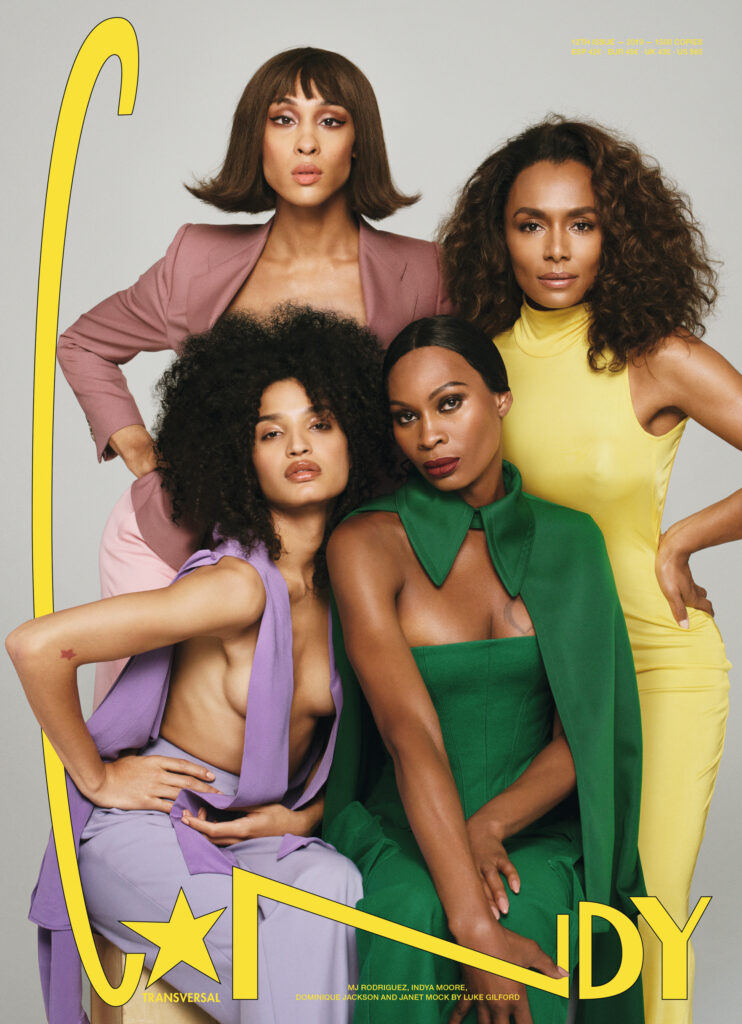
This story appears in the pages of V148: now available for purchase!
Discover More
